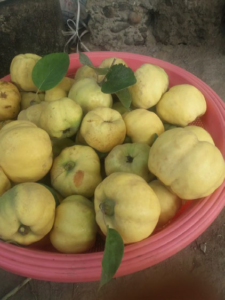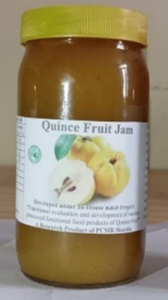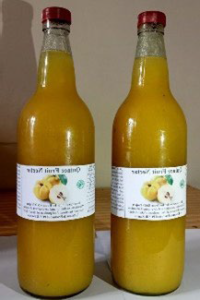INTRODUCTION
Quince fruit (Cydonia oblonga) belongs to the genus Cydonia, a native of Iran and Turkey. It is found across the sub-Himalayan tract, and in Gilgit-Baltistan, it is found at an altitude of up to 8000 feet. Quince fruit has been known since 4,000 B.C. Quince trees are also grown in the Mediterranean. Quince fruit is now also found in the Middle East, Latin America, and the United States. Quince trees are deciduous and grow to be 6-8 meters tall and 5-7 meters wide, with some fruits. When compared to tropical areas, high-altitude quinoa is harder and less juicy.1,2 It is called bahi in Urdu and shadool in Balti, bihi dana in Kashmir.3 The mature quince is golden yellow in color and pear-shaped.4,5 Initially, the fruit is covered with abundant hairs, but after ripening, the hairs disappear. The fruit has a woody texture and an acidic and astringent flavor. The local community of Himalaya used quince fruit after product development or used fruit after cooking due to astringent feel.6 Quince is a temperate fruit that requires 20 °C for proper ripening before being processed. The fruit is collected in autumn near October.7
The fruit boasts the body to fight free radicals and lower the danger of diseases as it contains vitamins A, C, and copper. It also possesses antiviral properties. Quince has a negligible amount of fat, and having an ample amount of crude fiber is good for digestion and helps reduce cholesterol. The fruit has a cooling effect and provides energy to the brain and heart, so its regular use maintains proper health.8 The liquid extract of the fruit is used for ulcers as well as scalds. The remaining dry pits and skin powder were used to treat soreness of the throat and coughing.9 Some Asians use quince fruit to treat constipation, diarrhea, and dysentery.10 The extract puree of quince fruit was also found effective in urinary and diabetic patients.11

In Gilgit-Baltistan, Pakistan, it is grown in some areas, but its usage is limited. It is hardly used for table purposes. The people analyzed are unaware of its use, processing, and value addition. Keeping in view its tremendous nutritional value, the study was done to analyze the fruit for its nutritional composition and develop value-added products such as fruit nectar and jam. The fruit and developed value-added products were examined for physical, chemical, and organoleptic analysis.
MATERIALS AND METHODS
The ripened quince fruits were purchased from the Kachura Skardu market and processed at Pakistan Council of Scientific and Industrial Research (PCSIR) Laboratories processing hall in Skardu. Other additives and preservatives like potassium metabisulphite, citric acid, and pectin purchased from Skardu local market. The value-added therapeutic food products were developed in the process development section of PCSIR Laboratories, Skardu.
Physical and Chemical Evaluation of the Quince Fruit and Developed Products
For physical evaluation, select five randomly weighed fruits: diameter (Vernier caliper), peel, edible portion, and seed. For the determination of nutritional and chemical constituents, the processed quince fruit pulp was analysed for protein, ash, and fat content (Anon., 2000). The Kjeldahl apparatus (Glass Model, Pyrex) was used for the assessment of protein (Method 960.52).
For ash content at 550 °C, method 923.03 was used. Soxhlet apparatus (J.P. Selecta – Spain) was used for the estimation of fat content (Method 920.39 C). Total soluble solids (TSS) were detected using a refractometer (Atago 3810 – Japan) and expressed as Brix. pH and acidity were determined by using methods such as Anon. (2000). Mean value of data was computed.
Processing of Pulp and Development of Value-added Products Nectar and Jam
The quince fruit is a thoroughly washed fruit with an unattractive shape. The small fruits are chopped, cooked, and obtained as pulp. The cooked pieces of quince fruit passed through the pulpier and were converted into pulp using the pulpier machine. The A-grade fruits are suggested for fresh sale and table use. Quince fruit pulp is used to develop jam. Products developed according to PCSIR Skardu’s methods. Five (5) kilogram pulp was taken and boiled up to 68° Brix, for nectar pulp pasteurized up to 85 °C the product was developed according to the below given flow sheet diagram.
Flow sheet diagram of fruit jam
Washing/Cooking
↓
Pulping
↓
Weighing
↓
Sugar addition
↓
Boiling and stirring
↓
Brix checking (64 B)
↓
Addition of preservative sodium benzoate
↓
Addition of pectin
↓
Addition of citric acid
↓
Jar filling
↓
Cooling
↓
labelling
↓
Jam ready for sale
↓

Flow sheet diagram of Nectar
Washing/Cooking
↓
Pulping
↓
Weighing of pulp
↓
Addition of sugar
↓
Pasteurization of pulp for up to 85 °C
↓
Addition of preservative sodium benzoate
↓
Addition of citric acid
↓
Bottling of nectar
↓
labeling
↓
Nectar ready for sale
↓

The value-added products were analyzed for physical parameters, organoleptic evaluation, TSS content, moisture, fat, fiber, ash, total sugars, protein, acidity12,13 and mineral contents.
Organoleptic and Sensory Evaluation of Value-added Products Nectar and Jam
Organoleptic evaluation for flavor, appearance, color, taste, consistency, and overall acceptability is conducted by Larmond using the nine-point hedonic scale.14,15 The selected panel has the ability to discriminate and has experience with a range of attributes of value-added product examination.
An orientation program was organized for members. The developed value-added products, nectar, and jam were provided to the members for organoleptic and sensory evaluation, and questionnaires were given to record their observations. Larmond’s nine-point hedonic scale parameters are given on the Performa, i.e., 9=liked extremely; 8=liked very much; 7=liked moderately; 6=liked slightly; 5=neither liked nor disliked; 4=disliked slightly; 3=disliked moderately; 2=disliked very much; 1=disliked extremely. The panelists expectorated the samples and rinsed their mouths with drinking water between samples. The experiment was repeated twice and the values are presented as means.16
RESULTS AND DISCUSSION
Physical Parameters
The collected, washed quince fruit is golden yellow in color and pear- or apple-shaped. The weight of five fruits ranged from 0.625- 0.675 grams’ length 27 cm and width 26 cm and the total proportion of peel, pulp, and seed were 4.3%, 90.7%, and 4.9% respectively.17 The data for physical calculation is presented in Table 1.
| Table 1. Physical Parameters of Quince Fruit |
|
Parameters
|
Attributes |
| Weight |
0.625 g
|
|
Color
|
Golden yellow |
| Shape |
Pear-shaped
|
|
Length
|
27cm |
| Width |
26cm
|
|
Pulp
|
90.7% |
| Peel |
4.3%
|
|
Seed
|
4.9
|
Sensory evaluations were done after the development of value-added products using the nine-point hedonic scale described by Larmond. The products were examined for their appearance, flavor consistency, taste, and overall acceptability, as shown in Table 2. Based on organoleptic and sensory evaluations, both nectar and jam were liked very much and received the highest score.
| Table 2. Organoleptic Evaluation of Developed Products Quince Nectar and Jam Parameters Nectar |
|
Parameters
|
Nectar |
Jam |
| Appearance |
8.8 |
8.8
|
|
Flavor
|
8.7 |
8.5 |
| Consistency |
8.1 |
8.5
|
|
Taste
|
8.8 |
8.5 |
| Overall acceptability |
8.6 |
8.5
|
Chemical Composition of Quince Fruit
The chemical composition of quince fresh fruit and developed products nectar and jam were analyzed. The tests were done in duplicate, and the mean value was taken for data calculation. Chemical composition data is given in Table 3. The average total soluble solid content to fresh fruit is 12.2% moisture was 84.1%, crude protein was 0.39%, total ash content is 2.5, crude fat content was recorded at 0.06% while crude fiber content was recorded at 4.9%, percent, total sugars 9.4 and reducing sugars recorded was 5.8%. As far as the nutritional composition of the fruit is concerned, quince is a good source of vitamin C, i.e., it has 19.6 mg per 100 g and titratable acidity, i.e., malic acid is 1.2%. the mineral content has a Vitol roll in the body detected calcium 17.9 mg/100 g, sodium 7.85 mg/100 g, potassium 235.2 mg/100 g, phosphorus 24.8 mg/100 g and iron 1.0 mg/100 g.
| Table 3. Chemical and Nutritional Composition of Quince Fruit |
|
Gene Symbol
|
T Cluster ID |
Description |
Fold Change
|
|
Moisture
|
84.1% |
PH |
3.48 |
| Protein |
0.39% |
Acidity |
1.25
|
|
Ash
|
3.18% |
Vitamin C |
19.6 mg/100 g |
| Crude fat |
0.06% |
Calcium |
17.9 mg/10 g
|
|
Fiber
|
4.9% |
Sodium |
7.85 mg/10 g |
| TSS (Brix) |
12.2 B |
Potassium |
235.2 mg/10 g
|
|
Reducing sugar
|
5.8% |
Phosphorus |
24.8 mg/10 g |
| Total sugar |
9.4% |
Iron |
1.0 mg/100 g
|
Chemical Composition of Developed Products Nectar and Jam
The value-added product jam developed boiling apple pulp with to a thickness of 68-degree brix.16 The chemical composition of developed value-added products is presented in Table 4. The amounts of vitamin C contained in the developed value-added products of quince nectar and jam are 14.3 and 11.9 mg/100 g, respectively. It was found that nectar has more ascorbic acid than jam. The pH values of the developed products recorded were 3.6 in nectar and 3.5 in jam. Quince fruit nectar contained a total titrate able acidity of 0.7 and jam 0.81. Reducing sugars and total sugar content of developed products nectar and jam recorded were 21.3, 65.2 and 28.2, 68.5 respectively. The developed products, nectar and jam, have recorded total ash contents of 2.9 and 2.4%, respectively. It is a good indicator for a measure of the total amount of mineral content.
| Table 4. Chemical Composition of Developed Products Quince Nectar and Jam |
|
Parameters
|
Nectar |
Jam
|
|
Vitamin C mg/100g
|
14.3 |
11.9 |
| pH value |
3.6 |
3.5
|
|
Total titrate able acidity
|
0.7 |
0.81 |
| Total sugar % |
40.1 |
46.9
|
|
Reducing sugar %
|
21.3 |
28.20 |
| Total soluble solids (TSS) |
65.2 |
68.5
|
|
Total ash content %
|
2.9
|
2.4
|
CONCLUSION
It is concluded that quince fruit is a highly nutritious underutilized fruit of Gilgit-Baltistan that can be used as a nutritious therapeutic fruit due to its high vitamin C content as compared to developed value-added products, and thus it can be used for table purposes. The developed value-added products were well-accepted as compared to the fresh quince fruit because it has an astringent and bitter odor. Both the developed products, nectar and jam, were liked very much and got the highest score; hence, considering their nutritive value and being liked very much organoleptically, both products, nectar, and jam, can be developed commercially for human consumption and can be used as a new source of income generation for rural communities in Gilgit-Baltistan.
ACKNOWLEDGEMENTS
This research work was supported by PCSIR Skardu, so the authors are thankful to PCSIR Skardu for
providing funds and for allowing them to conduct this research study. The authors would like to acknowledge the help extended to us by PCSIR Lahore, Pakistan, for providing cooperation in this study.
INSTITUTIONAL REVIEW BOARD APPROVAL
The research paper was submitted with the consent of the Director PCSIR laboratories and it was permitted to be published in any open-access journal.
CONFLICTS OF INTEREST
The authors declare that they have no conflicts of interest.








